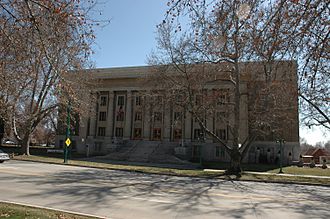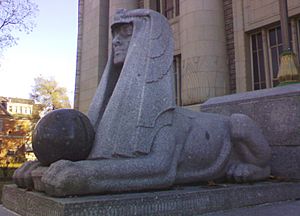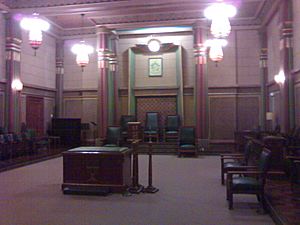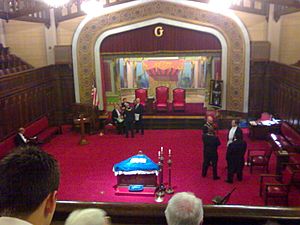Salt Lake Masonic Temple facts for kids
Quick facts for kids Salt Lake Masonic Temple |
|
|---|---|

Salt Lake Masonic Temple, front view from across South Temple Street, March 2010
|
|
| General information | |
| Architectural style | Egyptian Revival |
|
Salt Lake Masonic Temple
|
|
|
U.S. Historic district
Contributing property |
|
| Location | South Temple Street Salt Lake City, Utah United States |
| Area | 119 acres (48.2 ha) |
| Built | 1926 |
| Architect | Multiple |
| Architectural style | Mixed (more than 2 styles from different periods) |
| Part of | South Temple Historic District (ID82004147) |
| Added to NRHP | July 14, 1982 |
| Location | Salt Lake City, Utah, United States |
| Coordinates | 40°46′08″N 111°52′20″W / 40.76889°N 111.87222°W |
| Construction started | 1926 |
| Completed | 1927 |
| Cost | approximately $250,000.00 (1927) |
| Design and construction | |
| Architect | Carl W. Scott |
The Salt Lake Masonic Temple is the main building for Masons in Utah. It is a great example of Egyptian Revival architecture in Salt Lake City. This unique building was finished in 1927. You can find it in the South Temple Historic District of Salt Lake City, Utah, United States.
Contents
What is the Salt Lake Masonic Temple?
The Salt Lake Masonic Temple is a large building with many different rooms. It has several meeting rooms, called Lodge rooms, and bigger halls. There are also many lounges, a large banquet hall, and an auditorium. The building includes a library and offices for the people who manage it.
Today, the Temple is home to the main Masonic group in Utah. It also hosts five local Masonic Lodges from Salt Lake City. Other related groups, like the Scottish Rite and York Rite, also meet here. Groups for ladies and young people who are part of the Masonic family use the building too. The Temple has been used continuously since it opened in 1927. It is kept in good condition by a special association.
How is the Temple Used?
The main reason for the building is to hold meetings and ceremonies for the different Masonic groups in Salt Lake City. It also provides a central place for all the administrative work of the Utah Masonic family. Besides Masonic events, the building can also be rented by other groups or people for their own events.
History of the Salt Lake Masonic Temple
The idea to build the Salt Lake Masonic Temple started in 1920. The old Masonic building was too small for all the members in Salt Lake City. The architect and the building committee visited other Masonic Temples. They wanted to see what designs worked well and what didn't.
In the end, they decided that the Salt Lake Masonic Temple should be special. It would not be a copy of any other temple. By 1925, the building plans were ready, the land was bought, and the inside decorations were chosen. A lot of thought went into how to include Masonic symbols in the building. They discussed if these symbols should be hidden or easy to see.
Unique Features and Egyptian Style
The Salt Lake Masonic Temple is famous for its Egyptian Revival architecture. This style was chosen for a few reasons. First, Egyptian designs were very popular when the Temple was built. Second, most other temples used older, classical styles. The Egyptian look made this Temple truly unique. Third, the Egyptian style allowed for many Masonic symbols to be included. These symbols could blend in without making the building look strange.
The outside of the Temple is made of "Temple Brick." This special type of brick was designed just for this building. It later became a popular choice for other buildings too.
Light is a very important symbol in Freemasonry. The architect included many Egyptian ideas about light in the Temple's design. For example, there are many references to the Egyptian god Horus. At the time, people thought Horus was a god of Light. You can see these references on the main entrance.
The Temple has three entrances, which is a nod to the three Lights of a Masonic Lodge. The main entrance is on the north side of the building. In Masonic ritual, the north is seen as a place of darkness. So, people entering through the front door are seen as moving towards light.
Near the main entrance, there is a ramp with a scarab on top. A scarab is an Egyptian symbol for new life and never-ending life. Along with seven acacia trees next to the ramp, these symbols represent Masonic beliefs about a higher power and the soul living forever. The main entrance has a staircase with steps in groups of three, five, seven, and nine. Two sphinxes stand on either side of the staircase. Each sphinx holds a sphere, one showing the sky and one showing the Earth. They look like they are thinking deeply about their spheres.








